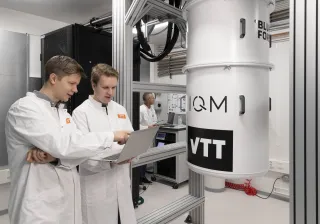As Finland prepares to start building the country’s first quantum computer, VTT’s Himadri Majumdar, the newly appointed manager for quantum programme, prepares for the challenges of nurturing disruptive technologies.
Managing innovation is a tricky, albeit rewarding, line of work. Understanding innovation while also having the vision to foresee the business it can generate is difficult. You can have all the faith in the world in the potential and the disruptive power of the innovation you’re working on, and yet, there is endless room for doubt: Can I prove the value of this innovation to the world? How do I justify investments to the management or the board? What if the expectations are premature? What if it all goes wrong?
Somehow, to me, the answer is as easy as it is difficult; customer is king. If the market does not see the immediate value of an innovation, its theoretical brilliance can quickly loose its value. A point that Clayton Christensen's book, the Innovator’s Dilemma elaborates very well.
As I start my new role as Manager, Quantum at VTT, this is something I know will keep me on my toes for the coming years. I am stepping into a role that hands me a first row seat in a ride that few have had a chance to experience. I acknowledge the opportunities of being part of developing a technology that I genuinely believe can and will disrupt industries and change the world as we know it. But I am also aware of the challenges that come with the role and I trying my best to prepare accordingly.
If the market does not see the immediate value of an innovation, its theoretical brilliance can quickly loose its value.

Isolation is the enemy of innovation
One thing has been clear to me since my early days as a scientist myself - innovation rarely happens in isolation. While the value of disruptive innovation is – in the strictest sense – often defined by intellectual property, and the ownership of IP considered key to future success, it is nevertheless important to co-operate and validate.
Validating ideas, hypotheses, results, and business plans are all key essentials to ensure future success. To succeed is to cooperate. The Quantum Computer procurement project is set to be a co-innovation program. This will help us immensely to ensure that VTT’s quantum technologies and solutions are competitive by global standards, and this is only the beginning. The co-innovation and co-development will continue in conjunction with our peers in other RTOs and universities in the form of various ecosystem and public-funded projects.
We do not innovate for the sake of innovation, but as said, to bring valuable applications to market.
We do not innovate for the sake of innovation, but as said, to bring valuable applications to market. That is why we also want to engage in dialogue with our future customers in the form of early strategic alliances and partnerships to explore the future of Quantum and to envision its impact on their businesses. The importance of being involved with our fellow-members in the EU to create a strong European policy for a Quantum future is also immense. The future success of the innovation depends on public awareness and identification of early business opportunities. This is what we strive for at VTT.
Finally, I am a strong believer in the idea that there are no small countries or organisations, only small ambitions. We all recognise and understand our limitations, but it is essential to keep the spark for innovation alive, always. So, let us dissociate our thoughts on such limitations and get entangled in the path of disruptive innovation.






